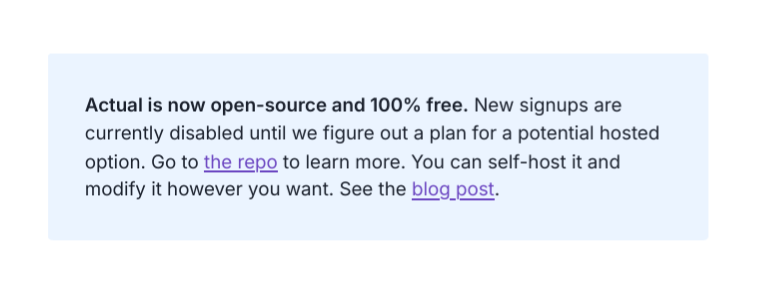

They recommend SimpleFIN instead of Plaid: https://old.reddit.com/r/selfhosted/comments/1cmfk8x/actualbudget_has_anyone_written_a_plaid_importer/


They recommend SimpleFIN instead of Plaid: https://old.reddit.com/r/selfhosted/comments/1cmfk8x/actualbudget_has_anyone_written_a_plaid_importer/


You jumped to a conclusion on pricing and made a mistake, it’s ok, no big deal.


Lol you weirdo, I even said I did that:


Try clicking either of those links.
Regardless, this is a thread about self-hosted open-source budgeting, which is why I linked to Actual Budget. I have updated the first post to be the Github link instead to prevent confusion.


all I saw was pricing […] can you really blame me?
I mean I really can. They don’t have any paid option so you definitely didn’t see any pricing. They only have a big open source message:



You’re replying to my comment about Actual Budget, the very open source budgeting solution?


Net worth and investment tracking goes in my spreadsheets, budgeting in Actual Budget.


deleted by creator


Why not Actual Budget, which is also self-hosted, open-source bucket budgeting based off YNAB, however it appears to be a lot more mature.
They also transparently run the project on Open Collective which I like: https://opencollective.com/actual
Any cloud is a secure backup on Linux if you use rclone crypt :)
It works with Google Drive, Dropbox, One Drive, and countless others to create an encrypted cloud storage, where the cloud provider can never view your file contents.


Very true. The discussion helped me, as I did think it meant not easily editable.
As root of course you can change the system to be any other type of system (layer packages, rebase, whatever), but I did assume it meant not easily modifiable in it’s current state.


My comment in the comment chain was:
An attacker escaping from a container can’t be system root as Podman runs rootless (without some other exploit or weak password).
We could give the op the benefit of the doubt and thinking that they were saying that the attacker inside the container managed to gain root inside the container.


While you are correct, any system is compromised if you have root, so isn’t that irrelevant at that point?


Makes sense. An “immutable” distro provides no additional security benefit, however CoreOS does have a reduced attack surface area compared to other distros, which itself is a benefit.


edit: “Immutable” means “all of them are the same”, not “unchangeable”.
You sound confident, but the fact that Fedora is using the term “immutable” makes me wonder if you actually have domain expertise here.
Immutable means immutable. It would be strange for them to call it that if it actually means “completely irrelevant from a security perspective”.
Unless you provide some evidence to the contrary I’m going to assume you aren’t correct.


They 100% can.
An attacker escaping from a container can’t be system root as Podman runs rootless (without some other exploit or weak password).
The filesystem itself is also read-only.
/dev/nvme0n1p4 on /sysroot type xfs (ro)
/dev/nvme0n1p4 on /usr type xfs (ro)
/dev/nvme0n1p3 on /boot type ext4 (ro)


Selfhosted Gitea is a way to get a wiki, bug tracker or whatnot - collaborate, for example, but it’s not necessary to have a Git server for your personal use.
No, but it is amazing for browsing your repos and visually seeing what you did in a past commit or a branch, while your IDE is open to your latest code. Or copying and pasting something that you need from a different repo.
For Git experts, sure they can probably do all that better inside their IDE or CLI, but for us plebs, having your own Forgejo is incredible 😍
I have mine configured to disable the wiki and issues, etc, it’s just the repo browser.


deleted by creator
Just remember that Cloudflare decrypts and re-encrypts all your data, so they can read absolutely everything that passes through those tunnels.